Inquiring Examination
- Chills and fever
- Perspiration
- Appetite, thirst and taste
- Defecation and urination
- Pain
- Sleep
- Sex and reproductive system
- Obtaining a history in children
As in the Modern Medicine, TCM physicians will start a consultation by inquiring about the patient's immediate complaint, its onset and duration and relevant medical history. He will then proceed to specially ask about about chills and fever, perspiration, appetite and taste, defecation and urination, pain and sleep. Women are likely to be asked about their menses and obstetric history, while childern asked about skin eruption. Sometimes, a simple or subtle sign may be significant clinical clue to discern what the problem is by TCM physicians.
A song created by Zhang Jiebin (1563-1640 AD) in the Ming Dynasty, called the "Ten Questions Song," was used as an outline for guiding TCM physicians about what questions to ask their patients. It was later supplemented by other scholars.
Ten Questions Song First ask fever and chills, Second ask sweat, Third ask head and body, Fourth ask stools and urine, Fifth ask diet and appetite, Sixth ask chest, Seventh ask hearing, Eighth ask thirst, Ninth ask old disease, Tenth ask cause. For women, menstruation and birth history will especially be asked, while children will be asked about measles and chicken pox. |
The first consultation may be lengthy and patients may be asked for details concerning present symptoms and even seemingly irrelevant questions! The answers give clues to the physician about the possible causes for the complaint and how best to treat it. Below are the underlying meanings about the questions inquired by TCM physicians during a consultation.
Chills and fever
Inquiring about a person's reaction to cold and heat can help to distinguish between exogenous or endogenous causes of illness, and also to know whether it is a exterior or exterior problem, and even belongs to yin or yang.
- Chills and fever indicate invasion of the body by exogenous pathogenic factors. If chills are predominant, it indicates an invasion by wind-cold, but if fever predominates, wind-heat is to be blamed.
- Chills without fever reflects endogenous cold caused by weakness of yang qi. This may also result from exogenous pathogenic cold affecting certain zang or fu organs.
- One may also experience fever without chills. Persistent high fever indicates excessive internal heat that can be resulted from invasion of exogenous heat evils, or the exogenous pathogens have entered from the exterior to the interior body. Low grade fever occurring at a definite time of day is called tidal fever, resulting from endogenous heat caused by yin deficiency.
Perspiration
Sweat is created by yang qi steaming and transforming yin fluids, which becomes evident when emerging from sweat pores on the body surface. Physician will ask whether the patient sweats or not. If yes, the following questions about when, where and how much the patient sweats are asked. By inquiring about patterns of perspiration, one can differentiate if the pathogenic force or healthy energy is strong or weak, and whether the sweat pores are opened or blocked. One can also know about the states of qi (vital energy) and blood inside the body.
- For cold and flu, sweating indicates the superficial portion of the body has been invaded by exogenous pathogenic factors, while the absence of perspiration means the condition is attacked by a combination of wind and cold evils.
- Frequent sweating upon slight exertion is referred to as spontaneous sweating, that usually occurs when yang-qi is insufficiency, and infirmity of protective qi.
- Night sweating occurs during sleep but ceases when the person awakes, which suggests a deficient yin.
Appetite, thirst and taste
Food and drink are necessities for maintaining functioning and vitality of body, which are sourced from the spleen and stomach to create nutrient essence. Inquiry about thirst, appetite and mouth taste reveal the functional states of these organs.
- Thirst combined with a desire for drinks is common in internal heat disharmony, body fluid depletion or kidney yin deficiency; while absence of thirst, or thirst without desire for drinks indicates cold or dampness accumulation.
- Preferences for cold food and beverages signifies a heat disharmony; while preference for hot food and beverages imply a cold disharmony.
- Poor appetite and the sensation of tasteless food and fullness in the abdomen indicate weakness of the spleen and stomach.
- Foul belching, acid regurgitation and nausea indicate retention of food.
- A sticky, sweet taste in the mouth reflects damp-heat; while a bitter taste suggests a hyperactive liver and gall-bladder.
Defecation and urination
The spleen and stomach govern the reception of water and food, and perform digestion and transformation functions to turn them into nutrient essence used by the body. The kidneys, large intestine, triple burner and urinary bladder are all involved in the urination and defecation processes and interact with the spleen and stomach. Hence, by inquiring about stools and urine, physicians can find out about the functioning of all these organs.
- Constipation with dry stool usually indicates heat in the intestines. However, if this occurs in the elderly, women after childbirth, or individuals with chronic illness, it usually indicates deficiency of qi and insufficient body fluids.
- If stools are passed with pus after painful straining, it indicates damp-heat in the intestines.
- Loose stool with undigested food reflects weakness of the spleen and stomach.
- Constant diarrhea before daybreak suggests yang deficiency of the spleen and kidneys.
- Deep yellow urine indicates heat type, while clear and profuse urine indicates cold type.
- Urgency, painful, scanty urination and in deep yellow color suggest accumulation of damp-heat in the bladder; while frequency with clear urine, incontinence, dribbling urine afterward are possibly due to insecurity of kidney qi.
- Dysfunction of the lungs, kidneys or spleen can lead to fluid retention in the body, and will produce little urine or no urine at all.
Pain
Pain is one of the most common complaints of patients. Apart from a thorough understanding of the history and accompanying symptoms and signs, TCM focuses on the nature and locations of pain. The nature of the pain helps to identify its etiology (cause) and pathology, while locality of the pain helps to determine which organs and meridians may be affected. For example the location of headache can indicate problems with different meridians.
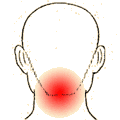 |
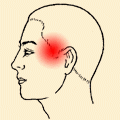 |
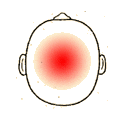 |
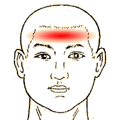 |
| Leg Tai Yang Bladder Meridian | Leg Shao Yang Gall Bladder Meridian | Leg Jue Yin Liver Meridian | Leg Yang Ming Stomach Meridian |
1. Nature of pain from a TCM perspective
Pain that is aggravated by pressure, acute onset, persistent and severe usually belongs to a excess (shi) type. That means the pain is mainly associated with obstruction of meridians, or stagnation of qi (vital energy) and blood caused by various pathogenic factors. Pain which is developed slowly, alleviated by pressure, mild and intermittent is usually caused by malnutrition of the tendons and collaterals due to insufficient qi (vital energy) and blood, and essence. If the pain is relieved by warmth, the pain belongs to a cold type; if the pain is relieved by cold, then it belongs to a heat type. Most migrating pain is due to invasion of collaterals by wind; fixed pain may be due to the obstruction of collaterals.
Below summarized the types, characteristics and clinical significance of pain from a TCM perspective:
| Type of pain | Characteristics | Clinical Significance |
| Distending pain | Pain accompanied by a distending sensation and appears intermittently | Qi stagnation e.g. distending pain in the chest suggests liver qi stagnation; distending pain in the head and eyes suggests hyperactivity of liver |
| Stabbing pain | Pricking pain, sharp in nature and fixed in location | Stagnate blood obstruction |
| Colic | The pain is sharp and violent, as though one is being ravaged by a knife | A sign of abrupt obstruction by substantial pathogenic factors, such as urinary stones, and angina |
| Retracting pain | Pulling pain, also called radiating pain | Malnutrition of the tendons, and mainly assoicated with liver disharmony |
| Burning pain | The pain is accompanied by burning sensation, and the pain is comforted by cooling | Pathogenic fire damages the meridians |
| Cold pain | The pain is accompanied by a cold feeling, and can be comforted by warmth | Excess cold or insufficient yang qi leads to loss of warmth in the body |
| Dull pain | This is a lingering and mild pain | Malnutrition of organs and meridians due to insufficiency of blood or qi (vital energy) |
| Hollow pain | The pain is accompanied by a sensation of emptiness | Insufficiency of blood or essence that fails to fill up the meridians |
| Heavy pain | The pain is accompanied by a sensation of heaviness | Excess dampness that disturbs functional activities of qi(vital energy) |
| Aching pain | The pain is accompanied by aches and weariness | This usually presents in exterior or dampness syndrome. Similar pain in the loins and knees is symptomatic of kidney deficiency |
2. Locations of pain from a TCM perspective
Obstruction in the above meridians can cause hypochondriac (rib sides) pain.
- Headache: The head is the pivot of blood and qi circulation, meeting place for the yang meridians and the brain is the sea of marrow. If there is pathogen invasions, stagnation of qi and blood, or blockage in the meridians, headache will ensue. TCM physician will identify the affected meridians according to the specific headache regions. They can also differentiate between different types of headache according to the nature of the headache and its associated other symptoms.
- Chest pain (1): The heart and lungs reside in the chest, chest pain usually indicates the associated problems.
- Hypochondriac pain (2, rib side pain): The hypochondriac region is traveled by the liver and gall-bladder meridians. Obstruction or malnutrition of these meridians may produce hypochondriac pain.
- Epigastric pain (3): This refers to the upper abdomen where the stomach is situated. Epigastric pain may result from invasion of the stomach by pathogenic cold, retention of food in the stomach, or invasion of the stomach by the liver qi.
- Abdominal pain: The abdomen is divided into the upper abdomen, lower abdomen and sides of the lower abdomen. The upper abdomen (4) refers to the area above the umbilicus and pertains to the spleen. The area below the umbilicus is the lower abdomen (5) and pertains to the kidney, bladder, large and small intestines and uterus. Both sides of the lower abdomen (6) are traveled by the liver meridian. So according to the locality of the pain, the diseased organs and meridians can be identified.
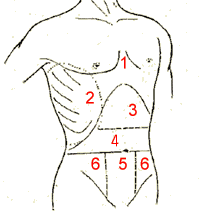
- Lumbar pain: The kidneys resides in the lumbar region, pain in it may result from obstruction of the meridians in the local area; besides, deficiency of the kidneys is also the cause.
- Pain in the limbs: Pain in the four limbs may be related to the joints or muscles, which may due to invasion of the exogenous pathogens, or bi syndrome.
Sleep
The Vital Axis states: "When yang qi is at its limit and yin qi is abundant, one's eyes are closed. When yin qi is at its limit and yang qi is abundant, one is awake." If the body's yin and yang are in harmony, one's sleep is normal. By asking about sleep patterns, physicians can gather clues about whether the disharmony belongs to a excess (shi) or deficiency (xu) type. Sleep patterns also give clues about what evils have invaded the body or if there present with qi disturbance.
- Insomnia refers to difficulty in falling sleep, inability to sleep soundly, waking easily and lying awake. Insomnia accompanied by dizziness and palpitation indicates insufficiency of blood that fails to nourish the spirit. Insomnia accompanied by restlessness and nightmares indicates heart fire blazing.
- Drowsiness is known as lethargy, if accompanied by low spirited, fatigue, dizziness, general heaviness, loose bowels and poor appetite, it may due to phlegm-dampness disturbing spleen; if accompanied by general weakness, slow mental response, aversion to coldness, and reluctant to move, then it may due to yang deficiency of heart and kidneys.
Sex and reproductive system
Physicians usually ask women about their menstrual cycles, vaginal discharges, pregnancy and childbirth history. These are the basis of female physiology and closely related to disease development on them.
- Short periods usually indicate blood over-heated;
- Long periods usually indicate blood stagnation or blood deficiency;
- Irregular periods may indicate spleen deficiency, qi stagnation or blood stasis;
- Heavy menses flow usually indicates blood over-heated or qi deficiency;
- Scanty and non-smooth flow usually indicates blood deficiency, blood stasis or phlegm obstruction;
- Clotty menses flow indicates qi stagnation and blood stasis;
- Bright red menses indicates a heat disharmony;
- Pale and thin menses indicates qi deficiency or phlegm obstruction;
- Dark purplish menses indicates blood stasis and qi stagnation.
- Excess vaginal discharge that is fishy smell and thin usually associated with dampness and coldness;
- Excess vaginal discharge that is yellow and foul smell usually associated with excess damp-heat;
- Grey-white discharge that is foul smell or blood tinted may indicate a serious condition.
- Abdominal pain with a heaviness feeling, lumbar soreness and bloody vaginal discharge may indicate a threatened abortion;
- Dizziness, limb numbness or spasm occur in the second or third trimester should be alert high blood pressure.
- Chills and fever after childbirth (puerperal fever) may indicate an infection in the uterus;
- Vaginal discharge (lochia) for a week or so after childbirth usually indicates blood stasis obstruction.
Obtaining a history in children
From a TCM viewpoint, a child's body is purely yang. Children have a tender and delicate yin-yang balance because their bodies are not yet fully developed. Their organs are fragile and delicate, therefore, they are easily attacked by exogenous evils and thus often cause diseases like flu and cold. Digestive problems are common too, because children themselves are not able to control their diet. Since they are under rapid growth and development, their disease courses tend to change rapidly, allowing them to either heal or aggravated quickly. Special attention is paid by physicians to these characteristics of development when examining a child.


